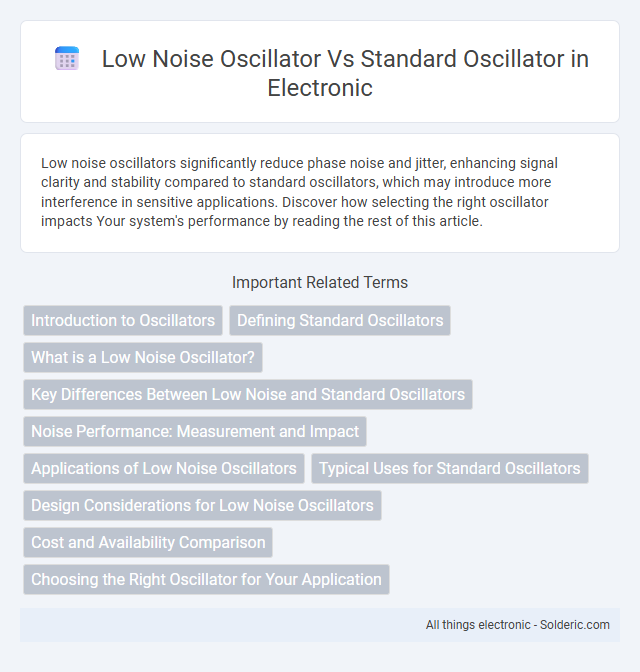Low noise oscillators significantly reduce phase noise and jitter, enhancing signal clarity and stability compared to standard oscillators, which may introduce more interference in sensitive applications. Discover how selecting the right oscillator impacts Your system's performance by reading the rest of this article.
Comparison Table
| Feature | Low Noise Oscillator | Standard Oscillator |
|---|---|---|
| Phase Noise | Extremely Low | Moderate to High |
| Frequency Stability | High | Standard |
| Signal Purity | High | Moderate |
| Power Consumption | Higher (due to noise reduction techniques) | Lower |
| Cost | Higher | Lower |
| Applications | RF Communications, Precision Measurements, High-end Audio | General Electronics, Consumer Devices |
| Output Signal | Clean, Stable | Basic, Less Stable |
Introduction to Oscillators
Low noise oscillators are designed to minimize phase noise and jitter, which improves signal clarity and stability in communication systems and precision instruments. Standard oscillators provide fundamental timing signals but may introduce higher noise levels, impacting performance in sensitive applications. Selecting the right oscillator influences your system's accuracy and overall reliability, especially in high-frequency or low-noise environments.
Defining Standard Oscillators
Standard oscillators generate periodic signals with fixed frequency and amplitude, commonly used in clocks, radios, and signal processing. They are designed for stability and reliability but can exhibit higher phase noise compared to low noise oscillators. Low noise oscillators minimize phase noise and signal jitter, improving performance in sensitive applications like communication systems and precision measurements.
What is a Low Noise Oscillator?
A Low Noise Oscillator is a specialized electronic oscillator designed to generate a stable frequency signal with minimal phase noise and signal jitter, essential for high-precision applications like communication systems and signal processing. Unlike standard oscillators that may produce higher noise levels affecting signal integrity, low noise oscillators enhance performance by reducing frequency instability and improving signal-to-noise ratio. This results in clearer, more accurate signals crucial for sensitive electronic equipment and RF systems.
Key Differences Between Low Noise and Standard Oscillators
Low noise oscillators minimize phase noise and signal distortion, providing exceptionally stable frequency output essential for high-precision communication and measurement systems. Standard oscillators exhibit higher noise levels and less frequency stability, making them suitable for general applications where ultra-low phase noise is not critical. Your choice should consider the required signal purity and system performance, as low noise oscillators enhance accuracy in sensitive electronic and RF circuits.
Noise Performance: Measurement and Impact
Low noise oscillators exhibit significantly lower phase noise and jitter compared to standard oscillators, improving signal integrity in high-frequency applications. Noise performance is typically measured using phase noise analyzers, quantifying noise power density in dBc/Hz at various frequency offsets from the carrier. Reduced phase noise directly impacts communication system reliability by minimizing bit error rates and enhancing signal-to-noise ratio in sensitive RF circuits.
Applications of Low Noise Oscillators
Low noise oscillators are critical in high-precision applications such as communication systems, radar, and signal processing, where phase noise directly impacts system performance and data integrity. These oscillators enhance signal clarity and accuracy by minimizing phase jitter, which is essential in GPS devices, high-frequency synthesizers, and advanced RF transceivers. Standard oscillators, while suitable for less sensitive applications, often introduce higher noise levels that can degrade the performance of sensitive electronic circuits.
Typical Uses for Standard Oscillators
Standard oscillators are commonly used in everyday electronic devices where precise frequency stability is not critical, such as in clock generation for microcontrollers, timing circuits, and simple radio frequency applications. They are favored for cost-effective solutions in consumer electronics like digital watches, basic communication devices, and household appliances. Standard oscillators provide reliable performance for general-purpose timing needs without the need for the ultra-low phase noise required in advanced signal processing or high-frequency communication systems.
Design Considerations for Low Noise Oscillators
Low noise oscillators require meticulous design strategies emphasizing component selection and circuit topology to minimize phase noise and signal jitter. Incorporating high-quality resonators and optimizing biasing conditions significantly improve frequency stability and reduce unwanted noise. Your choice of substrate materials and shielding techniques also plays a crucial role in achieving superior low noise performance compared to standard oscillators.
Cost and Availability Comparison
Low noise oscillators typically come at a higher cost than standard oscillators due to advanced design techniques and superior components aimed at minimizing phase noise. Standard oscillators are more widely available and cost-effective, making them suitable for general applications where ultra-low noise performance is not critical. Your choice depends on budget constraints and the specific noise requirements of your project, balancing cost with performance needs.
Choosing the Right Oscillator for Your Application
Low noise oscillators are essential for applications requiring superior signal purity, such as high-frequency communication systems and precision measurements, due to their minimal phase noise and jitter. Standard oscillators, while more cost-effective and easier to implement, are suitable for general-purpose applications where ultra-low noise performance is not critical. Selecting the right oscillator depends on balancing noise requirements, frequency stability, power consumption, and budget constraints specific to your electronic system.
Low noise oscillator vs Standard oscillator Infographic

 solderic.com
solderic.com